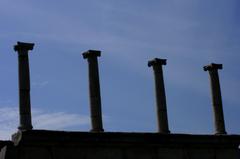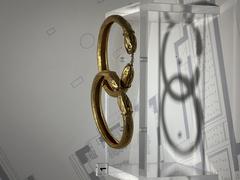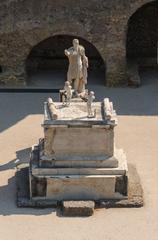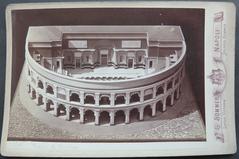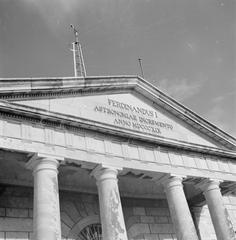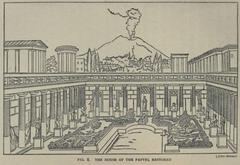Terme Suburbane Herculaneum: Visiting Hours, Tickets, Accessibility, and Historical Guide
Date: 04/07/2025
Introduction
Standing on the southern edge of ancient Herculaneum, the Terme Suburbane (Suburban Baths) are among the most evocative and remarkably preserved Roman bath complexes in the world. Built in the early 1st century CE under Marcus Nonius Balbus, these baths offer a window into the engineering sophistication, artistry, and vibrant social life of Herculaneum’s citizens. Their exceptional state of preservation—owing to the eruption of Mount Vesuvius in 79 CE—means visitors can admire original mosaics, frescoes, wooden doors, and marble furnishings rarely found elsewhere.
This guide provides a comprehensive overview for history enthusiasts, travelers, and cultural explorers. You’ll find detailed information about visiting hours, tickets, accessibility, site highlights, digital experiences, and practical tips for making the most of your visit. For real-time updates, consult the Parco Archeologico di Ercolano official website and consider using the ErcolanoDigitale app for immersive audio guides and augmented reality features (Napolike, The History Hub, Lonely Planet).
Table of Contents
- Origins and Construction
- Architectural Features and Preservation
- Social and Cultural Importance
- Rediscovery and Conservation
- Artistic and Decorative Highlights
- Practical Visitor Information
- Visitor Tips and FAQs
- Conclusion
- Sources
Origins and Construction
The Terme Suburbane were constructed in the early 1st century CE, reflecting a phase of prosperity in Herculaneum’s history after its transformation from a Greek and Samnite settlement to a Roman municipium (The History Hub). Commissioned by Marcus Nonius Balbus, a key magistrate and benefactor, the baths were strategically located just outside the city walls by the ancient shoreline, signifying both civic pride and the importance of bathing culture in Roman life (Napolike).
Architectural Features and Preservation
Thanks to the unique carbonizing effects of the Vesuvius eruption, the Terme Suburbane are exceptionally preserved, offering rare glimpses of wooden architectural elements and vivid frescoes (The History Hub). The baths include the classic sequence of Roman bathing chambers: apodyterium (changing room), frigidarium (cold room), tepidarium (warm room), and caldarium (hot room), all connected by a sophisticated hypocaust heating system and water management infrastructure.
Distinctive features include:
- Atrium with Impluvium: The entrance hall features a sunken basin and a fountain with a bust of Apollo, surrounded by red-painted columns (herculaneum.uk).
- Mosaic and Marble Floors: Intricate geometric and marine-themed mosaics cover floors and pool linings.
- Stucco and Fresco Decorations: Stucco friezes, mythological frescoes, and marble furnishings display Roman artistic mastery (herculaneumtickets.com).
Social and Cultural Importance
Bathing was central to Roman daily life, and the Terme Suburbane served not only as a place for hygiene and relaxation but also as a social hub for citizens of all classes (Napolike). The baths’ opulent decor rivaled that of private villas, reflecting the wealth and civic pride of Herculaneum’s elite.
Rediscovery and Conservation
Buried by up to 18 meters of volcanic debris in 79 CE, the Terme Suburbane were rediscovered during 18th-century excavations and have since undergone extensive restoration. Modern conservation strategies prioritize structural stabilization, the preservation of mosaics and stucco, and the protection of rare wooden components (Napolike). The site reopened to the public in 2017 after significant restoration.
Artistic and Decorative Highlights
- Mosaics: The baths are adorned with dynamic black-and-white and colored mosaics depicting marine life, mythological figures, and geometric motifs (herculaneumtickets.com).
- Frescoes: Well-preserved wall paintings showcase vibrant mythological and landscape scenes.
- Marble Furnishings: Benches, pool linings, and decorative inlays highlight luxury.
- Carbonized Wood: Rare wooden doors and beams provide insight into Roman construction techniques.
- Fountain Bust of Apollo: Merging utility with artistic splendor, this fountain is a highlight of the atrium (herculaneum.uk).
Practical Visitor Information
Visiting Hours
- March 16 – October 14: 8:30 am – 7:30 pm (last entry: 6:00 pm)
- October 15 – March 15: 8:30 am – 5:00 pm (last entry: 3:30 pm)
- Closed: January 1 and December 25
Always verify current opening hours on the official website.
Tickets
- Standard Adult: €16
- EU Youth (18–25): €2
- Under 18: Free
- Wheelchair users and one companion: Free (with documentation) (DisabledAccessibleTravel)
Tickets include access to the entire Herculaneum Archaeological Park, including the Terme Suburbane. Skip-the-line tickets and combination passes are also available (VisitPompeiiVesuvius).
Accessibility
- Pathways: Smooth main streets with ramps and metal bridges for wheelchair users.
- Facilities: Accessible toilets at the entrance, visitor center, and ticket office.
- Assistance: Security staff and licensed guides are available for support (NaplesInsider).
- Neurodiversity: Multimedia guides for visitors on the autism spectrum available with advance notice.
- Maps: Detailed accessibility maps on the official park website.
Guided Tours and Digital Experiences
- Guided Tours: Official and private guides offer in-depth insights into the baths’ history and architecture.
- ErcolanoDigitale App: Features 3D reconstructions, multilingual audio guides, and augmented reality overlays (Ercolano Digitale). Download before arrival for the best experience.
Getting There
- By Train: Circumvesuviana line from Naples to Ercolano Scavi station (10-minute walk to the entrance) (TrueWindHealingTravel).
- By Car: Parking available near the site; adapted taxis and vehicles can be arranged in advance.
- By Bus: Infrequent shuttle service from Naples.
Nearby Attractions
- House of the Mosaic Atrium
- Villa of the Papyri
- House of the Deer
- Ancient Boathouses
- The town of Ercolano offers additional dining and museum options (TouristPlaces.Guide).
Visitor Tips and FAQs
Best Times to Visit
- Early mornings and late afternoons avoid peak crowds.
- Weekdays during the off-season (November–March) are quieter (Vacatis).
Safety and Regulations
- Wear sturdy shoes; surfaces are uneven.
- Respect barriers and conservation areas.
- No food inside; water bottles allowed.
FAQs
Q: Are Terme Suburbane tickets separate from Herculaneum tickets?
A: No; all Herculaneum Archaeological Park tickets include the Terme Suburbane.
Q: Is the site accessible for wheelchairs?
A: Yes, with designated routes and facilities. Contact staff for assistance if needed.
Q: Are specialized guided tours available?
A: Yes, official guides offer tours focused on the baths’ history and architecture.
Q: Can I take photos inside?
A: Non-flash photography is allowed throughout the site.
Q: How do I reach Terme Suburbane from Naples?
A: Take the Circumvesuviana train to Ercolano Scavi, then follow signs to the site.
Conclusion
The Terme Suburbane at Herculaneum offer a rare combination of ancient Roman architectural brilliance, artistic achievement, and immersive visitor experiences. From their origins as a social and hygienic hub to their rediscovery and ongoing conservation, these baths invite visitors to step into a world frozen in time. Plan your visit using the latest information on opening hours, accessibility, and guided tours, and enhance your journey with digital tools like the ErcolanoDigitale app. Explore nearby attractions for a full day of historical discovery and cultural enrichment.
For ongoing updates, consult the official website and follow related social media channels. Your journey into Roman antiquity awaits at the Terme Suburbane—a must-see for anyone visiting the Bay of Naples.
Sources
- Napolike: Terme Suburbane Herculaneum Guide
- Lonely Planet: Terme Suburbane Herculaneum
- Parco Archeologico di Ercolano – Official Site
- VisitPompeiiVesuvius: Herculaneum Information
- The History Hub: Herculaneum Facts and Pictures
- Herculaneum UK: Suburban Baths Documentation
- Tourist Places Guide: Herculaneum Attractions
- DisabledAccessibleTravel: Herculaneum Accessibility
- TrueWindHealingTravel: Herculaneum Sightseeing Guide
